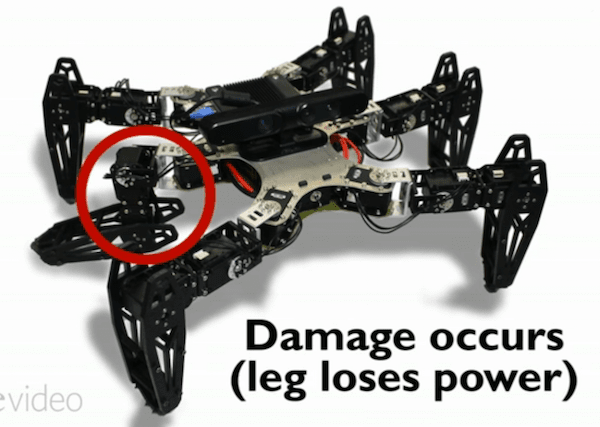Six-legged robot can rapidly modify its walk on losing one foot
Humans claim superiority over machines because of the smart skills we have and one of them is the ability to adapt quickly. But guess what? Robots aren't far behind in catching up to humans. In a recent research work presented by a team at INRIA, a national computer science agency in France, it has come to light that a six-legged robot has apparently got the ability to start limping if it loses one of its foots. Much like us humans, robots one day hope to be able to resort to the quickest measure it can think of to solve the problem at hand. With the French team's research work, it seems that the day is not too far.
Jean-Baptiste Mouret, an AI researcher at INRIA and his team have come up with a restorative algorithm that enables a robot to undergo fast recovery by rapidly modifying its motion to cope with the damage done to it. Such a robot seems highly useful on a rescue mission in a disaster struck area. Although it seems only obvious that robots can be pre-programmed so that they know what to do when a certain situation occurs, there's always a possibility of the unforeseen happening. Having robots work for long hours with little or no human intervention is the ultimate goal anyway.

In their strategy, the roboticists made the six-legged robot use a shortcut in face of damage. In that, the robot (whose leg is stuck or amputated) uses a camera to identify that there's something wrong which is making it unable to walk straight or getting really slow. Instead of diagnosing this issue, the robot has been designed to try out different patterns of motions until it finds one that brings it back to the original level of performance.
To achieve this feat, the research team equipped the bot with a database of 13,000 walking patterns and made it choose the correct one by narrowing down the search based on plausible movements. With such powerful information under its belly, the robot could start walking normally in less than a minute. Not only did the robot adapt to mechanical failures, but it could adjust its gait & limp to correspond to the environment and the terrain.
Take a look at the video to see a demonstration -
The team is hopeful that their restorative algorithm could be of use to almost any robot out there and can be further enhanced to suit more complex robots.
What are your thoughts about the exciting new research work? Share with us in comments below.
Source: #-Link-Snipped-#
Jean-Baptiste Mouret, an AI researcher at INRIA and his team have come up with a restorative algorithm that enables a robot to undergo fast recovery by rapidly modifying its motion to cope with the damage done to it. Such a robot seems highly useful on a rescue mission in a disaster struck area. Although it seems only obvious that robots can be pre-programmed so that they know what to do when a certain situation occurs, there's always a possibility of the unforeseen happening. Having robots work for long hours with little or no human intervention is the ultimate goal anyway.

In their strategy, the roboticists made the six-legged robot use a shortcut in face of damage. In that, the robot (whose leg is stuck or amputated) uses a camera to identify that there's something wrong which is making it unable to walk straight or getting really slow. Instead of diagnosing this issue, the robot has been designed to try out different patterns of motions until it finds one that brings it back to the original level of performance.
To achieve this feat, the research team equipped the bot with a database of 13,000 walking patterns and made it choose the correct one by narrowing down the search based on plausible movements. With such powerful information under its belly, the robot could start walking normally in less than a minute. Not only did the robot adapt to mechanical failures, but it could adjust its gait & limp to correspond to the environment and the terrain.
Take a look at the video to see a demonstration -
What are your thoughts about the exciting new research work? Share with us in comments below.
Source: #-Link-Snipped-#
Replies
You are reading an archived discussion.
Related Posts
Every language has its own nuances. Being a student of Japanese language, I try to find the most mysteriously beautiful things about the pictographic world of "Nihongo".
Over the course...
Quote:
How would you like to work in a building shaped like a picnic basket? Or maybe you would like to visit a building made with limestone, rocks and shells...
Upcoming Android M platform will have 'App Permissions'. For example, if you start WhatsApp on your new phone, the app will ask for a permission to access your microphone. Once...
Google's announced the next major upgrade to Android operating system, called 'Android M'. At the Google I/O 2015 conference, the major features of the new version were just announced. Let's...
I'm wondering what are the minimum hardware requirements for Android M. Google announced the latest version of Android at IO 2015 conference, but did not mention the release date or...
